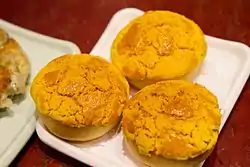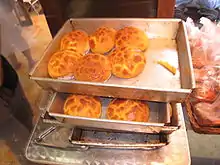 | |
| Alternative names | Bo lo baau |
|---|---|
| Type | Sweet bun |
| Place of origin | Hong Kong |
| Main ingredients | Sugar, eggs, flour, and lard |
| Pineapple bun | |||||||||||||||||
|---|---|---|---|---|---|---|---|---|---|---|---|---|---|---|---|---|---|
 | |||||||||||||||||
| Traditional Chinese | 菠蘿包 | ||||||||||||||||
| Simplified Chinese | 菠萝包 | ||||||||||||||||
| Literal meaning | pineapple bun | ||||||||||||||||
| |||||||||||||||||

A pineapple bun (Chinese: 菠蘿包; Sidney Lau: boh1loh4baau1) is a kind of sweet bun predominantly popular in Hong Kong[1] and also common in Chinatowns worldwide.[2] Despite the name, it does not traditionally contain pineapple; rather, the name refers to the look of the characteristic topping (which resembles the texture of a pineapple).
History
The history of the pineapple bun, also known as Ba Lo Bao, can be traced back to the post-World War II era in Hong Kong. During this time, there was a significant influence of Portuguese culture in the region. As migrants returned to Hong Kong, they sought to incorporate Western elements into the local cuisine while also adapting to local flavors.[3]
In the 1940s a family named the Ng family, who had been among those deported during the war, opened their own restaurant in Hong Kong. Drawing inspiration from the traditional Mexican pastry known as a concha, they decided to create their own version with a slight twist. This unique variation came to be known as pineapple buns or Ba Lo Bao, despite not containing any actual pineapple as an ingredient.[3]
The earliest documented evidence of the pineapple bun can be traced back to Hong Kong in 1942. It was during this time that the Tai Tung Bakery first opened its doors to the public. The shop owner, Tse Ching-yuen, recalls that he has been making pineapple buns since he was just 11 years old. However, he acknowledges that there were similar baked goods in Japan before that period.[4]
In June 2014, the Hong Kong Government listed the pineapple bun as a part of Hong Kong's intangible cultural heritage. Tai Tung Bakery in Yuen Long, which had been making pineapple buns for more than 70 years, was a key proponent of including the technique for making the buns on the list of 480 items of living heritage.[5]
Composition
The top of the pineapple bun (the part which is made to resemble a pineapple) is made of a dough similar to that used to make sugar cookies, which consists of sugar, eggs, flour, and lard. It is crunchy and is quite sweet compared to the bread underneath. The bread dough underneath is that which is used in Hong Kong–style breads, which is a softer and sweeter dough than in European breads. It is popular at breakfast or afternoon tea.
Although it is known as a "pineapple bun", the traditional version contains no pineapple. The name originated from the fact that its sugary top crust is cooked to a golden-brown colour, and because its checkered top resembles the skin of a pineapple.[6]
Buttered variant
_(3476646912).jpg.webp)
Many Hong Kong restaurants, such as cha chaan tengs and dai pai dongs, offer an item called a buttered pineapple bun, which is a pineapple bun with a slice of butter stuffed inside. They are known in Cantonese as boh loh yau (菠蘿油), in which boh loh means "pineapple", and yau (oil) refers to butter. Variants of this include using custard in place of butter.
Typically the bun is brought hot from the oven to the diner's table, and served halved with a large slab of butter in between the halves.
Other common variants
The pineapple bun may come in miniature sizes (迷你菠蘿包), it may be used as a bread roll for sandwiches with luncheon meat (餐肉菠蘿包), or it may be pre-stuffed with red bean paste (紅豆菠蘿包), custard cream (奶黃菠蘿包), barbecued pork (叉燒菠蘿包), or a sweet filling of shredded coconut (椰絲菠蘿包) like that in a cocktail bun. It is possible to order a "pineapple pineapple bun", actually stuffed with pineapple (菠蘿菠蘿包).
Japanese melonpan and Korean soboro bread[7] are variants that use the same ingredients for a German streusel-like texture on top but without resemblance to a pineapple.
Controversy
In October 2020, a Japanese bakery c'est très fou launched the product "Taiwanese pineapple bun", which received criticism for suggesting the product originated in Taiwan, though the bakery's introduction of the product had correctly mentioned that the bun originated in Hong Kong.[8]
See also
- Bun
- List of buns
- Concha (bread), the Mexican equivalent of pineapple bun
- Melonpan, the Japanese equivalent of pineapple bun
References
- ↑ "Hong Kong food: 40 dishes we can't live without - 6. 'Pineapple' bun". CNN Travel. 13 July 2010. Retrieved 5 January 2014.
- ↑ "What Is a Pineapple Bun". wisegeek. Conjecture Corporation. Retrieved 5 January 2014.
- 1 2 "Pineapple Bun: A Breakfast Dish And Symbol Of Cultural Heritage". Slurrp. Retrieved 12 June 2023.
- ↑ "What Hong Kong-Style Pineapple Buns Are Really Made Of". Tasting Table. 8 September 2022. Retrieved 12 June 2023.
- ↑ Tsang, Denise (8 September 2014). "The secrets behind serving up Hong Kong's 'hot cross buns'". No. 8 September 2014. South China Morning Post. Retrieved 23 November 2014.
- ↑ "Where's The Pineapple?". My Kitchen: My Laboratory. 27 May 2007. Retrieved 29 June 2009.
- ↑ "Korean Soboro Bread". Korean Slate. 28 October 2009. Retrieved 24 August 2011.
- ↑ 子萱, 楊 (19 January 2021). "Japan wrongly called the inventor of Hong Kong pineapple buns". The China Post, Taiwan. Retrieved 3 October 2021.